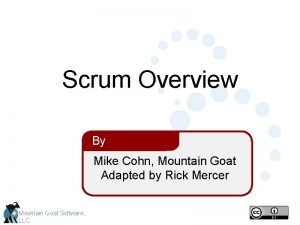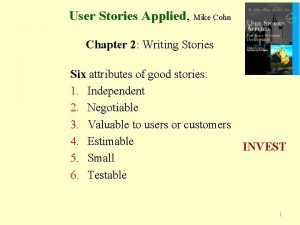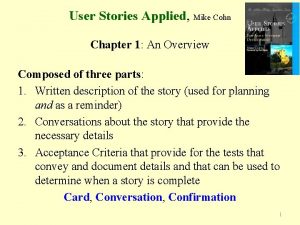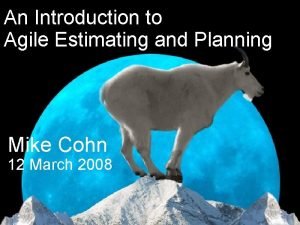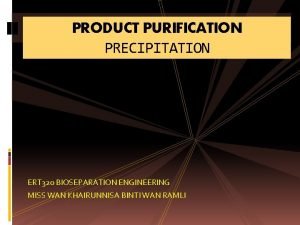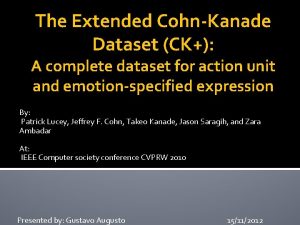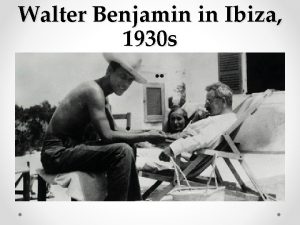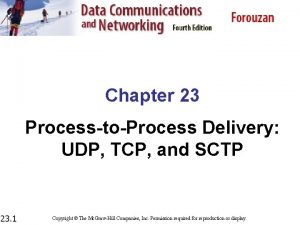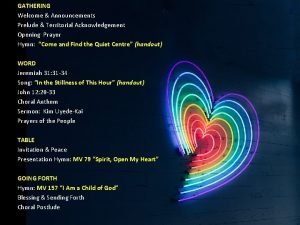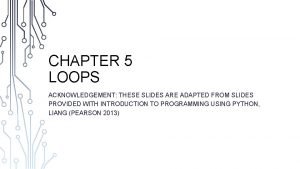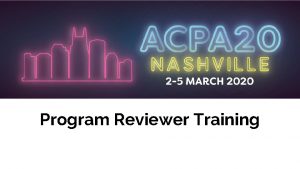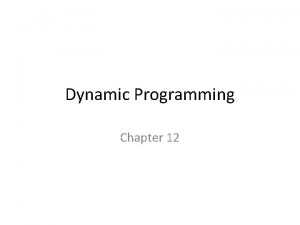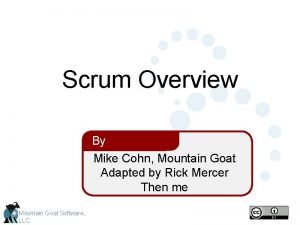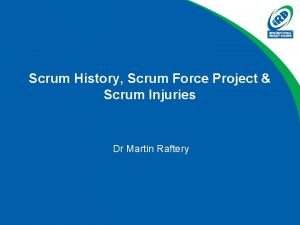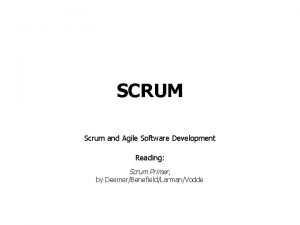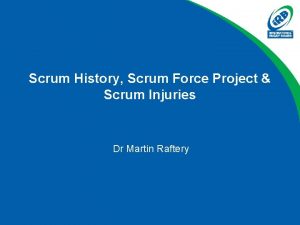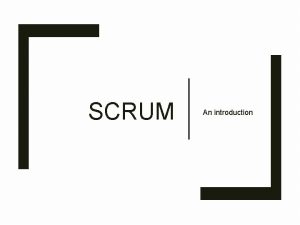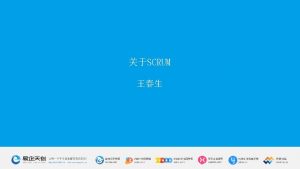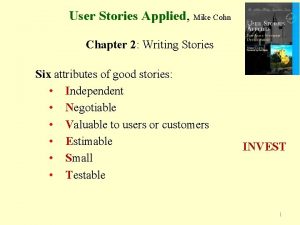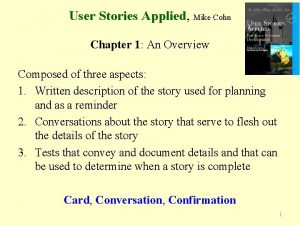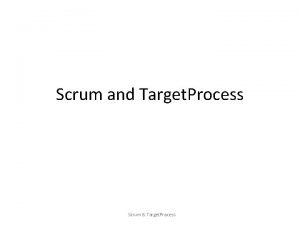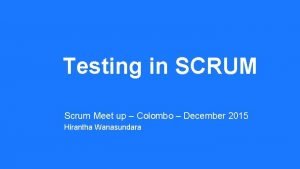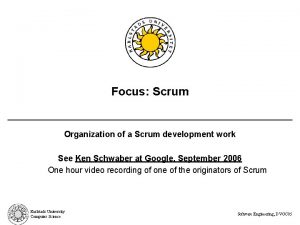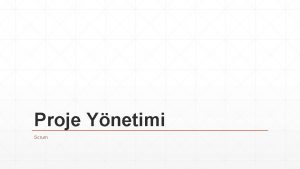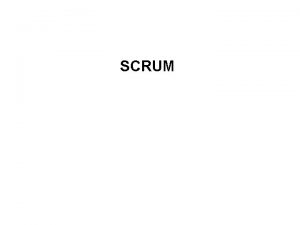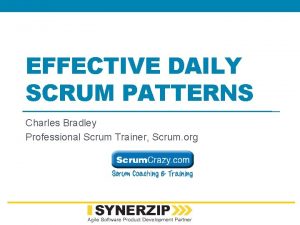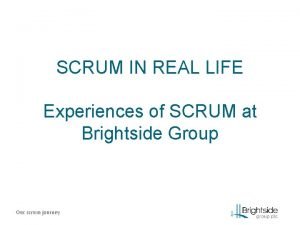SCRUM SCRUM WITH ACKNOWLEDGEMENT TO MIKE COHN FROM

























- Slides: 25

SCRUM

SCRUM WITH ACKNOWLEDGEMENT TO MIKE COHN FROM MOUNTAIN GOAT SOFTWARE, LLC

We’re losing the relay race “The… ‘relay race’ approach to product development…may conflict with the goals of maximum speed and flexibility. Instead a holistic or ‘rugby’ approach—where a team tries to go the distance as a unit, passing the ball back and forth—may better serve today’s competitive Hirotaka Takeuchi and Ikujiro Nonaka, “The requirements. ” New Product Development Game”, Harvard Business Review, January 1986.

Scrum in 100 words • Scrum is an agile process that allows us to focus on delivering the highest business value in the shortest time. • It allows us to rapidly and repeatedly inspect actual working software (every two weeks to one month). • The business sets the priorities. Teams self-organize to determine the best way to deliver the highest priority features. • Every two weeks to a month anyone can see real working software and decide to release it as is or continue to enhance it for another sprint.

Scrum origins Jeff Sutherland • Initial scrums at Easel Corp in 1993 • Ken Schwaber • Scrum presented at OOPSLA 95 with Sutherland • Mike Beedle • Scrum patterns in PLOPD 4 • Ken Schwaber and Mike Cohn • Co-founded Scrum Alliance in 2002 •

SCRUM has been used Microsoft Embedded systems Yahoo 24 x 7 systems Google Video games EA FDA approved systems Siemens Websites Nokia Mobile phones Intuit Network switching Saleforce. com Joint Strike Fighter

Characteristics Self-organizing teams Product progresses in a series of month-long “sprints” Requirements captured in “product backlog” No specific engineering practices prescribed Uses generative rules to create an agile environment for delivering projects


Project noise level Far from Agreement Requirements Anarchy m Mountain Goat Software, LLC pl ica te d Simple Technology Source: Strategic Management and Organizational Dynamics by Ralph Stacey in Agile Software Development with Scrum by Ken Schwaber and Mike Beedle. Far from Certainty Co Close to Certainty Close to Agreement Complex

The Process © www. mountaingoatsoftware. com/scrum

Sprints Scrum projects make progress in a series of “sprints” Typical duration is 2– 4 weeks or a calendar month at most A constant duration leads to a better rhythm Product sprint is designed, coded, and tested during the

Sequential vs. overlapping development Requirements Design Code Test Rather than doing all of one thing at a time. . . Scrum teams do a little of everything all the time Source: “The New Product Development Game” by Takeuchi and Nonaka. Harvard Business Review, January 1986.

Unified (Software Development) Process Iterations within phases 4 phases and core workflows for each Inception Requirements Analysis Design Implementation Test Elaboration Construction Transition

No changes during a sprint Change Plan sprint durations around how long you can commit to keeping change out of the sprint

Scrum framework Roles • Product owner • Scrum. Master • Team Ceremonies • Sprint planning • Sprint review • Sprint retrospective • Daily scrum meeting Artifacts • Product backlog • Sprint backlog • Burndown charts

Product owner Define the features of the product Decide on release date and content Be responsible for the profitability of the product (ROI) Prioritize features according to market value Adjust features and priority every iteration, as needed Accept or reject work results

The Scrum. Master • Represents management to the project • Responsible for enacting Scrum values and practices • Removes impediments • Ensure that the team is fully functional and productive • Enable close cooperation across all roles and functions • Shield the team from external interferences

The team Typically 5 -9 people Cross-functional: Programmers, testers, user experience designers, … Members should be full-time May be exceptions (e. g. , database administrator) Teams are self-organizing • Membership should change only between sprints •

Team capacity Product backlog Business conditions Sprint planning meeting Sprint prioritization • • Analyze and evaluate product backlog Select sprint goal Sprint planning • Current product • Technology • Decide how to achieve sprint goal (design) Create sprint backlog (tasks) from product backlog items (user stories / features) Estimate sprint backlog in hours Sprint backlog

Sprint planning Team selects items from product backlog they can commit to Sprint backlog is created Tasks are identified and each is estimated (1 -16 hours) Collaboratively, not done alone by the Scrum. Master High-level design is considered As a vacation planner, I want to see photos of the hotels. Code the middle tier (8 hours) Code the user interface (4) Write test fixtures (4) Code the foo class (6) Update performance tests (4)

The daily scrum Daily 15 -minutes Stand-up Not for problem solving Whole world is invited Only team members, Scrum Master, product owner talk Helps avoid other unnecessary meetings

Everyone answers 3 questions What did you do yesterday? What will you do today? Is anything in your way? 1 2 3 not status for the Scrum. Master commitments in front of peers

A sample product backlog Backlog item Estimate Allow a guest to make a reservation 3 As a guest, I want to cancel a reservation. 5 As a guest, I want to change the dates of a reservation. As a hotel employee, I can run Rev. PAR reports (revenue-per-available-room) 3 8 Improve exception handling 8 . . . 30 . . . 50

Tasks Mon Tues Wed Thur Fri Code the user interface Code the middle tier Test the middle tier Write online help 8 16 4 12 8 10 7 8 16 16 11 12 50 40 30 Hours 20 10 0 Mon Tue Wed Thu Fri 8

Scaling through the Scrum of scrums
 Goat
Goat Story card example
Story card example Mike cohn user stories
Mike cohn user stories Agile estimating and planning by mike cohn
Agile estimating and planning by mike cohn Ferdinand cohn
Ferdinand cohn Cohn equation of precipitation
Cohn equation of precipitation Lillian cohn
Lillian cohn Ellen cohn yale
Ellen cohn yale Aaron cohn middle school
Aaron cohn middle school Extended cohn-kanade dataset (ck+)
Extended cohn-kanade dataset (ck+) Walter benjamin ibiza
Walter benjamin ibiza Lynn cohn mediator
Lynn cohn mediator Yossi cohn
Yossi cohn The value of acknowledgement field in a segment defines
The value of acknowledgement field in a segment defines The value of acknowledgement field in a segment defines
The value of acknowledgement field in a segment defines Acknowledgement for presentation
Acknowledgement for presentation Acknowledgement for presentation
Acknowledgement for presentation Acknowledgement prayer
Acknowledgement prayer Acknowledgement slides
Acknowledgement slides Acknowledgement
Acknowledgement Acknowledgement introduction
Acknowledgement introduction Acknowledgement slides
Acknowledgement slides Kaurna acknowledgement for schools
Kaurna acknowledgement for schools Tcp selective ack
Tcp selective ack Acpa land acknowledgement
Acpa land acknowledgement Egg drop dynamic programming
Egg drop dynamic programming
